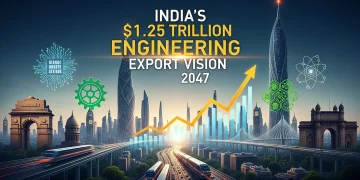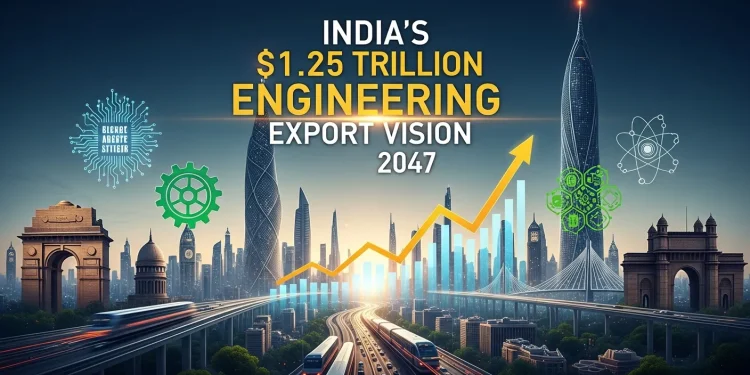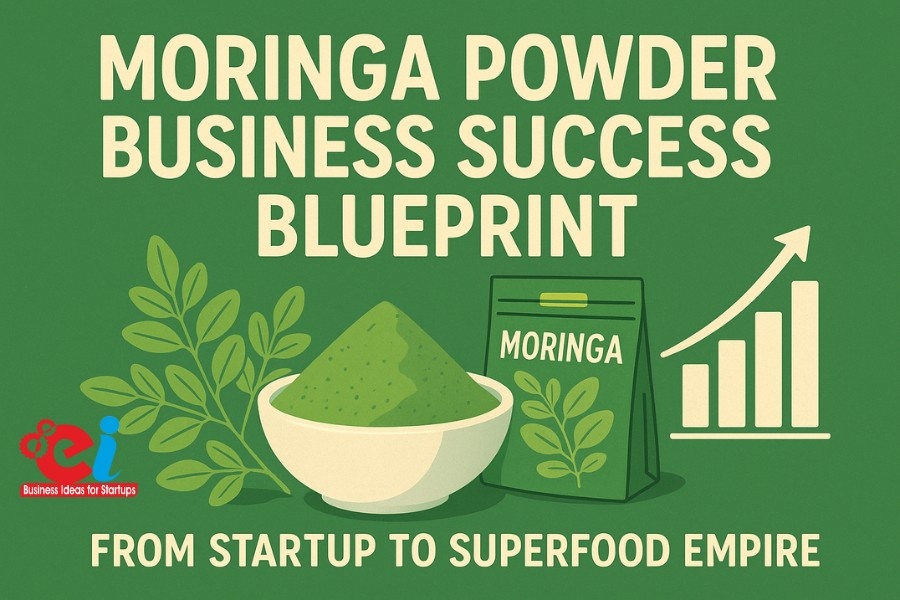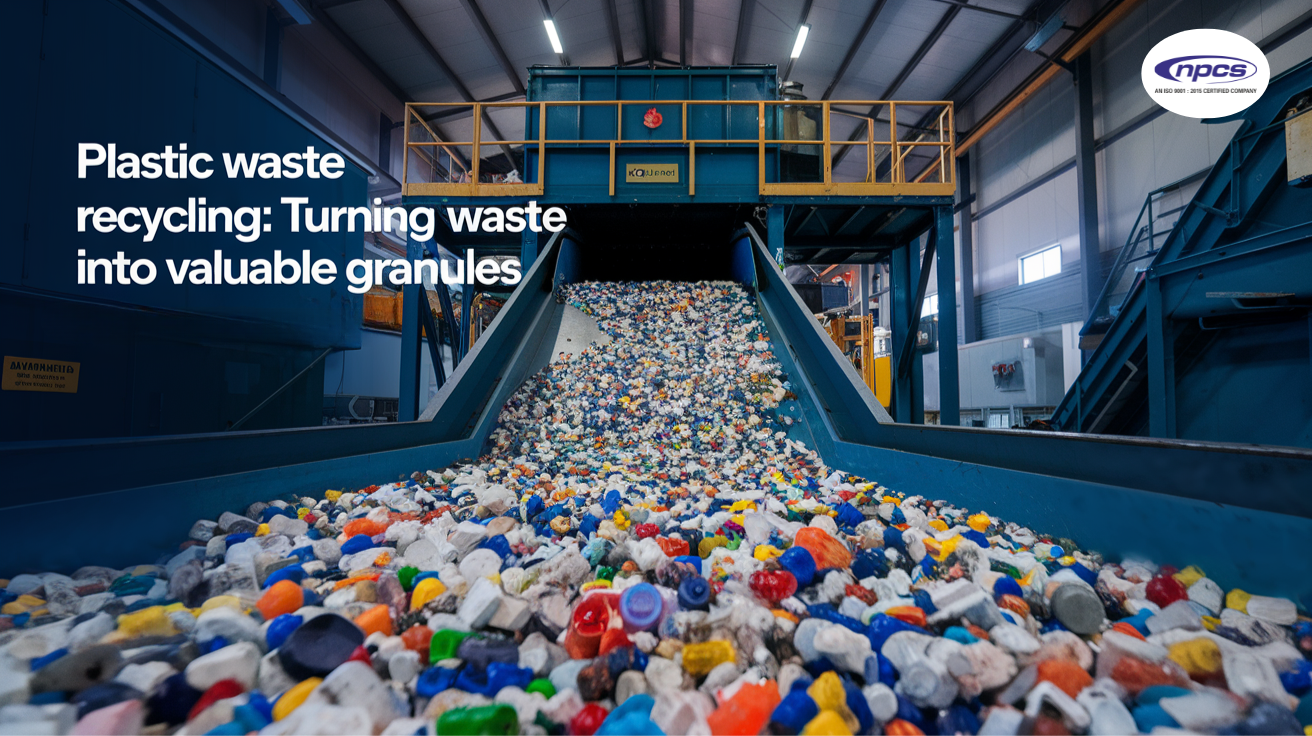The Future of Indian Exports: The Future of Indian Exports: India’s growing export sector is changing the country. India is expecting to achieve USD 1.25 trillion in engineering exports by the year 2047, the year India celebrates 100 years of independence, which is a bold target.
Additionally, since engineering is already 25% of India’s exports, it will remain a crucial sector in the years to come. As such, this sector will also create a unique opportunity for startups to build world-class export businesses. As a result, new entrepreneurs will be a part of the global success story of India.
India’s engineering exports stood at $116.67 billion in the FY 2024-25, which is steady growth compared to the previous year. Furthermore, engineering goods make up 26% of India’s total exports. The other engineering export markets include the USA, UAE, UK, Singapore, and Germany.
The export of engineering goods to these countries, such as vehicles, electrical machinery, auto components, medical instruments, and aircraft parts, is helping India to accelerate economically. Therefore, this will open up many more engineering export markets, which will enable India to finance new ventures and have more future confidence.
Read Our Book: Click Here
Vision 2047: India’s $1.25 Trillion Export Goal-The Future of Indian Exports
Currently India only holds 1% of global engineering exports. The goal by 2047 is to gain 8% to 10% of global engineering exports. To achieve this goal, India will need a more digitally innovative economy and advanced manufacturing along with green technology.
Startups with new-age and high-value products will be the primary beneficiaries from this goal. Rapidly growing global trends will enable these new-age companies to scale at tremendous rates. Hence, the goal of 2047 is a strategic approach to long-term growth.
Read More: How MSME Engineering Exports Are Shaping India’s Global Trade Future
Key Growth Sectors and Startup Opportunities-The Future of Indian Exports
Several fast-growing industries will shape India’s engineering future. Each of these industries will spawn numerous entrepreneurial ventures, offering integration into global supply chains.
The current entrepreneurial construction of these industries will provide early mover advantages. Following are some of the high potential industries. This means entrepreneurial ventures will satisfy a high demand and growing supply.
Aerospace and Defence-The Future of Indian Exports
Startups can provide construction of precision components, electronic systems, materials, and UAV parts, Especially with the global interest and 114% growth of India’s aircraft and spacecraft exports.
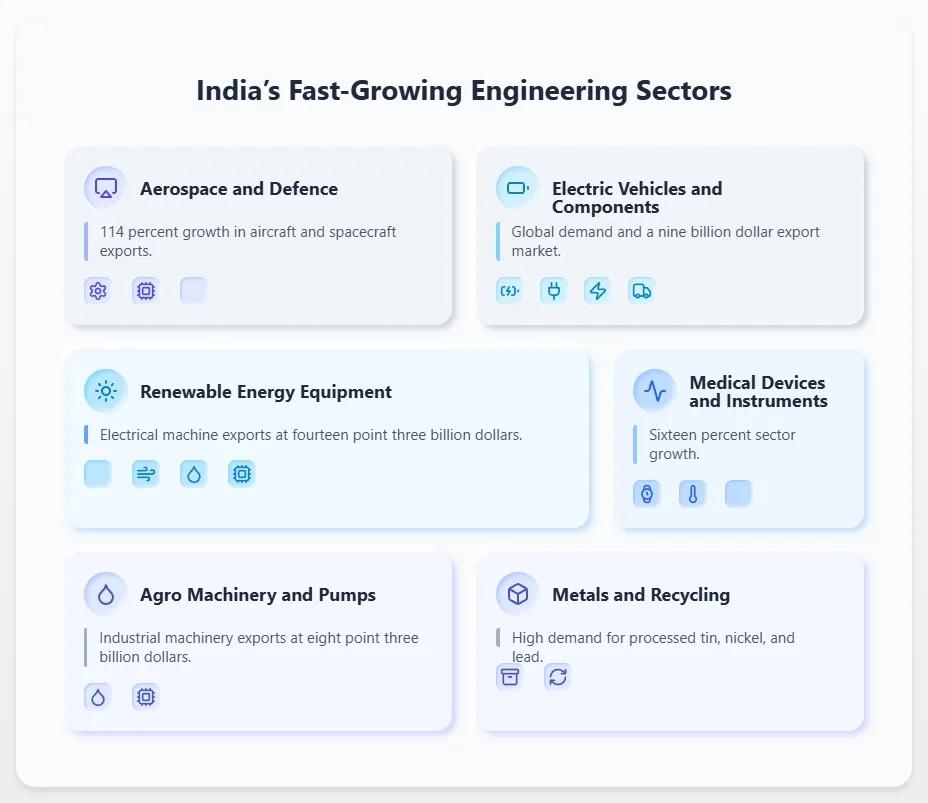
Electric Vehicles and Components
There is currently a global rise in demand for vehicles and especially EVs as well as the $9 billion export business. Entry within the construction of EV batteries, charging technology, EV electronics, and materials will profit new startups(The Future of Indian Exports).
Renewable Energy Equipment
Electrical machine exports reached $14.3 billion. Startups can focus on solar panels, parts for wind turbines, hydrogen systems, smart energy devices, etc.
Setting Up of Planetarium Profitable Investment Opportunity in Astronomy Education Sector.
Medical Devices and Scientific Instruments
16% is the growth in this sector, and it requires diagnostic devices, fitness trackers, wearables, instruments for biotechnology, low-cost health devices, etc.
Agro-Machinery and Pumps
Export of industrial machinery surpassed $8.3 billion. Startups can produce irrigation pumps, machines for food processing, and other farming tools that are low-cost for developing countries(The Future of Indian Exports).
Metals and Recycling
Processed tin, nickel, and lead are on high demand. Startups in recycling can meet the need for processed metals for manufacturers and suppliers worldwide.
How NPCS Helps Entrepreneurs Build Export-Oriented Businesses
NPCS assists entrepreneurs in the preparation of comprehensive and user-friendly feasibility reports, encompassing market studies, demand forecasting, production methodologies, product mix strategies, machinery and raw material listings, financial estimations, flow diagrams, profitability analysis, and so on.
Moreover, NPCS assists you in understanding the international export requirements, selecting the appropriate product mix, and designing the optimal layout for your factory. NPCS also assists you with government incentives, certifications, and strategies for business growth.
Thus, entrepreneurs can eliminate uncertainties and seamlessly transition from idea conception to implementation. Consequently, startups are able to establish robust and adaptable ventures that are export-led(The Future of Indian Exports).
Studying Import-Export Trends: Advice for Startups
Falling exports for base metals such as copper and aluminum remind us that recycling and substitution industry innovation must happen quickly. Startups must keep looking for these high demand industry opportunities, as evidenced by the demand for aerospace, medical, and EV parts.
Entrepreneurial focus on these fast-moving sectors allows startups to avoid the slow in demand markets and stay relevant and competitive on the global stage.
Read Our Project Report: Click Here
India’s Business Leaders: Insights to Inspire Young Entrepreneurs
Innovative global vision is the lesson from India’s top industrial leader, Ratan Tata. For Baba Kalyani, the lesson is precision engineering and scale to build Bharat Forge into a global leader in the forging industry.
Anand Mahindra teaches investing in diversification to stay future relevant, especially in EV, Aerospace, and Tractors. These shining examples of innovation truly inspire young entrepreneurs to grow their startups into highly innovative global businesses(The Future of Indian Exports).
Read More: A Startup Roadmap to Engineering Export Business Markets, Products & Opportunities
Startup Roadmap to Align with Export 2047 Goals
To help new businesses integrate themselves into India’s exportation goal, they need to first tap into high-potential industries (i.e., EVs, renewables, and aerospace). Along with this, obtaining international certifications (ISO, CE, and FDA) is crucial.
Using FTAs, collaborating with overseas companies, and R&D investment are key to increasing competitive advantage. It is then that effective strategic planning with NPCS and industry bodies is needed. This, then, speeds up success while minimising risks.
Find the Best Idea for Yourself With our Startup Selector Tool
Conclusion-The Future of Indian Exports
India aspires to increase engineering exports up to USD 1.25 trillion by 2047. This vision is audacious although it is the reality. Most of this growth is expected to come from newly established companies, resulting from innovative, qualitatively world-class and sustainable solutions.
There is tremendous potential in industries such as EVs, aerospace, medical devices, renewables, and many more. NPCS and established businesses provide mentorship, enabling new companies to significantly impact India’s engineering accomplishments. There is no better opportunity to close in on exports(The Future of Indian Exports).
FAQs-The Future of Indian Exports
What potential does India’s USD 1.25 trillion engineering export goal provide for startups?
It creates the potential for new businesses to export, providing products, parts, and technologies to new overseas markets. As new businesses grow, their export potential grows as well.
What areas are most appealing for novice exporters?
Among many sectors, some of the most appealing for exporters are Aerospace, Electric Vehicles, Renewable Energy Equipments, Medical Devices, Agro Machinery, and Metal Recycling, etc. They are the most expanding sectors with the highest global demand.
What must startups do to adapt their products for international markets?
Startups will need to adapt global criteria such as ISO, CE, and FDA. They will need to invest in proper quality control, certifications, and clean manufacturing which meets international standards.
What does NPCS provide entrepreneurs?
NPCS provides complete project reports, market studies, financial plans, and stepwise processes with lists of required machines along with mentoring on government schemes so that the startups can confidently establish manufacturing units for exports.
What do you think is the most appropriate action for most of the startups willing to participate in the export vision of India 2047?
Choosing a fast growing sector, doing a feasibility study, and understanding global market demand are important. Moreover, startups should obtain the required certifications to facilitate the manufacture of products that comply with international standards.
